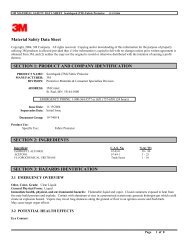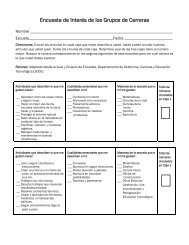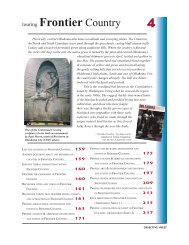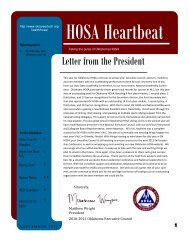Highlights of the 2010 Guidelines for CPR and ECC - ECC Guidelines
Highlights of the 2010 Guidelines for CPR and ECC - ECC Guidelines
Highlights of the 2010 Guidelines for CPR and ECC - ECC Guidelines
You also want an ePaper? Increase the reach of your titles
YUMPU automatically turns print PDFs into web optimized ePapers that Google loves.
l a y r e s c u e r a d u lt c p r<br />
Change in <strong>CPR</strong> Sequence: C-A-B Ra<strong>the</strong>r<br />
Than A-B-C*<br />
<strong>2010</strong> (New): Initiate chest compressions be<strong>for</strong>e ventilations.<br />
2005 (Old): The sequence <strong>of</strong> adult <strong>CPR</strong> began with opening <strong>of</strong><br />
<strong>the</strong> airway, checking <strong>for</strong> normal breathing, <strong>and</strong> <strong>the</strong>n delivery <strong>of</strong><br />
2 rescue breaths followed by cycles <strong>of</strong> 30 chest compressions<br />
<strong>and</strong> 2 breaths.<br />
Why: Although no published human or animal evidence<br />
demonstrates that starting <strong>CPR</strong> with 30 compressions<br />
ra<strong>the</strong>r than 2 ventilations leads to improved outcome, chest<br />
compressions provide vital blood flow to <strong>the</strong> heart <strong>and</strong><br />
brain, <strong>and</strong> studies <strong>of</strong> out-<strong>of</strong>-hospital adult cardiac arrest<br />
showed that survival was higher when byst<strong>and</strong>ers made<br />
some attempt ra<strong>the</strong>r than no attempt to provide <strong>CPR</strong>. Animal<br />
data demonstrated that delays or interruptions in chest<br />
compressions reduced survival, so such delays or interruptions<br />
should be minimized throughout <strong>the</strong> entire resuscitation. Chest<br />
compressions can be started almost immediately, whereas<br />
positioning <strong>the</strong> head <strong>and</strong> achieving a seal <strong>for</strong> mouth-to-mouth<br />
or bag-mask rescue breathing all take time. The delay in<br />
initiation <strong>of</strong> compressions can be reduced if 2 rescuers are<br />
present: <strong>the</strong> first rescuer begins chest compressions, <strong>and</strong> <strong>the</strong><br />
second rescuer opens <strong>the</strong> airway <strong>and</strong> is prepared to deliver<br />
breaths as soon as <strong>the</strong> first rescuer has completed <strong>the</strong> first<br />
set <strong>of</strong> 30 chest compressions. Whe<strong>the</strong>r 1 or more rescuers are<br />
present, initiation <strong>of</strong> <strong>CPR</strong> with chest compressions ensures that<br />
<strong>the</strong> victim receives this critical intervention early, <strong>and</strong> any delay<br />
in rescue breaths should be brief.<br />
BOX 2<br />
Number <strong>of</strong> Compressions Delivered<br />
Affected by Compression Rate <strong>and</strong><br />
by Interruptions<br />
The total number <strong>of</strong> compressions delivered during resuscitation<br />
is an important determinant <strong>of</strong> survival from cardiac arrest.<br />
The number <strong>of</strong> compressions delivered is affected by <strong>the</strong><br />
compression rate <strong>and</strong> by <strong>the</strong> compression fraction (<strong>the</strong> portion<br />
<strong>of</strong> total <strong>CPR</strong> time during which compressions are per<strong>for</strong>med);<br />
increases in compression rate <strong>and</strong> fraction increase <strong>the</strong> total<br />
compressions delivered, whereas decreases in compression<br />
rate or compression fraction decrease <strong>the</strong> total compressions<br />
delivered. Compression fraction is improved if you reduce<br />
<strong>the</strong> number <strong>and</strong> length <strong>of</strong> any interruptions in compressions,<br />
<strong>and</strong> it is reduced by frequent or long interruptions in chest<br />
compressions. An analogy can be found in automobile travel.<br />
When you travel in an automobile, <strong>the</strong> number <strong>of</strong> miles you<br />
travel in a day is affected not only by <strong>the</strong> speed that you drive<br />
(your rate <strong>of</strong> travel) but also by <strong>the</strong> number <strong>and</strong> duration <strong>of</strong> any<br />
stops you make (interruptions in travel). During <strong>CPR</strong>, you want<br />
to deliver effective compressions at an appropriate rate (at least<br />
100/min) <strong>and</strong> depth, while minimizing <strong>the</strong> number <strong>and</strong> duration<br />
<strong>of</strong> interruptions in chest compressions. Additional components<br />
<strong>of</strong> high-quality <strong>CPR</strong> include allowing complete chest recoil after<br />
each compression <strong>and</strong> avoiding excessive ventilation.<br />
Elimination <strong>of</strong> “Look, Listen, <strong>and</strong> Feel<br />
<strong>for</strong> Breathing”*<br />
<strong>2010</strong> (New): “Look, listen, <strong>and</strong> feel” was removed from <strong>the</strong><br />
<strong>CPR</strong> sequence. After delivery <strong>of</strong> 30 compressions, <strong>the</strong> lone<br />
rescuer opens <strong>the</strong> victim’s airway <strong>and</strong> delivers 2 breaths.<br />
2005 (Old): “Look, listen, <strong>and</strong> feel” was used to assess<br />
breathing after <strong>the</strong> airway was opened.<br />
Why: With <strong>the</strong> new “chest compressions first” sequence, <strong>CPR</strong><br />
is per<strong>for</strong>med if <strong>the</strong> adult is unresponsive <strong>and</strong> not breathing<br />
or not breathing normally (as noted above, lay rescuers will<br />
be taught to provide <strong>CPR</strong> if <strong>the</strong> unresponsive victim is “not<br />
breathing or only gasping”). The <strong>CPR</strong> sequence begins with<br />
compressions (C-A-B sequence). There<strong>for</strong>e, breathing is briefly<br />
checked as part <strong>of</strong> a check <strong>for</strong> cardiac arrest; after <strong>the</strong> first set<br />
<strong>of</strong> chest compressions, <strong>the</strong> airway is opened, <strong>and</strong> <strong>the</strong> rescuer<br />
delivers 2 breaths.<br />
Chest Compression Rate: At Least<br />
100 per Minute*<br />
<strong>2010</strong> (New): It is reasonable <strong>for</strong> lay rescuers <strong>and</strong> healthcare<br />
providers to per<strong>for</strong>m chest compressions at a rate <strong>of</strong> at least<br />
100/min.<br />
2005 (Old): Compress at a rate <strong>of</strong> about 100/min.<br />
Why: The number <strong>of</strong> chest compressions delivered per<br />
minute during <strong>CPR</strong> is an important determinant <strong>of</strong> return<br />
<strong>of</strong> spontaneous circulation (ROSC) <strong>and</strong> survival with good<br />
neurologic function. The actual number <strong>of</strong> chest compressions<br />
delivered per minute is determined by <strong>the</strong> rate <strong>of</strong> chest<br />
compressions <strong>and</strong> <strong>the</strong> number <strong>and</strong> duration <strong>of</strong> interruptions in<br />
compressions (eg, to open <strong>the</strong> airway, deliver rescue breaths,<br />
or allow AED analysis). In most studies, more compressions are<br />
associated with higher survival rates, <strong>and</strong> fewer compressions<br />
are associated with lower survival rates. Provision <strong>of</strong> adequate<br />
chest compressions requires an emphasis not only on an<br />
adequate compression rate but also on minimizing interruptions<br />
to this critical component <strong>of</strong> <strong>CPR</strong>. An inadequate compression<br />
rate or frequent interruptions (or both) will reduce <strong>the</strong> total<br />
number <strong>of</strong> compressions delivered per minute. For fur<strong>the</strong>r<br />
in<strong>for</strong>mation, see Box 2.<br />
Chest Compression Depth*<br />
<strong>2010</strong> (New): The adult sternum should be depressed at least 2<br />
inches (5 cm).<br />
2005 (Old): The adult sternum should be depressed<br />
approximately 1½ to 2 inches (approximately 4 to 5 cm).<br />
Why: Compressions create blood flow primarily by increasing<br />
intrathoracic pressure <strong>and</strong> directly compressing <strong>the</strong> heart.<br />
Compressions generate critical blood flow <strong>and</strong> oxygen <strong>and</strong><br />
energy delivery to <strong>the</strong> heart <strong>and</strong> brain. Confusion may result<br />
when a range <strong>of</strong> depth is recommended, so 1 compression<br />
4 A m e r i c a n H e a r t A s s o c i a t i o n
















